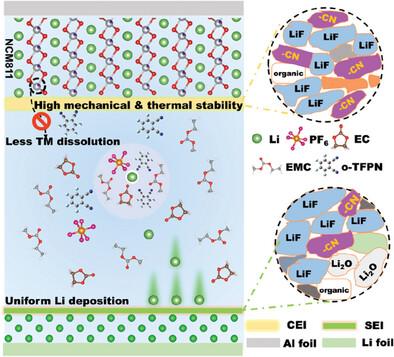Cyano-Functionalized Hybrid Electrode-Electrolyte Interphases Enabled by Cyano-Substituted Tetrafluorobenzene Derivatives Additives for High-Voltage Lithium Metal Batteries
IF 18.5
1区 材料科学
Q1 CHEMISTRY, MULTIDISCIPLINARY
引用次数: 0
Abstract
Lithium metal batteries (LMBs) operating at high voltages are attractive for their energy storage capacity but suffer from challenges: cathode instability, electrolyte consumption, and lithium dendrite growth. Modulating the electrode/electrolyte interphase (EEI) with functional additives is a practical strategy. Herein, a cyano (-CN)-functionalized hybrid EEI strategy is proposed to develop electrolytes for high-voltage Li||LiNi0.8Co0.1Mn0.1O2 (Li||NCM811) battery with -CN-substituted tetrafluorobenzene derivatives (tetrafluorophthalonitrile (o-TFPN), tetrafluoroisophthalonitrile (m-TFPN)), and tetrafluoroterephthalonitrile (p-TFPN)) as additives. The results demonstrate that the electrolyte-containing additives, particularly o-TFPN-contained electrolyte, can derive a robust, and thermally stable cathode electrolyte interphase (CEI) enriched with LiF and -CN groups. Furthermore, the o-TFPN-contained electrolyte forms a stable solid electrolyte interface (SEI) with Li2O, LiF, and -CN. The -CN group generates electrostatic attraction, guiding Li+ flux, while LiF and Li2O with high ionic conductivity facilitate rapid Li+ deposition. The excellent EEI suppresses cathode degradation, electrolyte consumption, and dendrite formation. Therefore, the Li||NCM811 battery achieves stable performance over 200 cycles at 4.6 V, while the Li||Li symmetric cell stably cycles for over 350 h at a current density of 1 mA cm−2.

用氰基取代四氟苯衍生物添加剂实现高压锂金属电池中氰基功能化杂化电极-电解质界面
在高压下工作的锂金属电池(lmb)因其储能能力而具有吸引力,但也面临着阴极不稳定、电解质消耗和锂枝晶生长等挑战。用功能添加剂调制电极/电解质界面相(EEI)是一种实用的方法。本文提出了一种氰基(-CN)功能化的杂化EEI策略,以-CN取代的四氟苯衍生物(四氟眼腈(o-TFPN)、四氟对眼腈(m-TFPN)和四氟对苯二甲酸(p-TFPN)为添加剂,开发高压Li bb| |LiNi0.8Co0.1Mn0.1O2 (Li||NCM811)电池的电解质。结果表明,含电解质添加剂,特别是含o- tfpn的电解质,可以得到一个强大的,热稳定的阴极电解质界面(CEI),富含LiF和-CN基团。此外,含有o- tfpn的电解质与Li2O、LiF和-CN形成稳定的固体电解质界面(SEI)。-CN基团产生静电吸引,引导Li+通量,而离子电导率高的LiF和Li2O有利于Li+的快速沉积。优异的EEI抑制阴极降解、电解质消耗和枝晶形成。因此,Li||NCM811电池在4.6 V下可稳定循环超过200次,而Li||Li对称电池在1 mA cm−2电流密度下可稳定循环超过350小时。
本文章由计算机程序翻译,如有差异,请以英文原文为准。
求助全文
约1分钟内获得全文
求助全文
来源期刊

Advanced Functional Materials
工程技术-材料科学:综合
CiteScore
29.50
自引率
4.20%
发文量
2086
审稿时长
2.1 months
期刊介绍:
Firmly established as a top-tier materials science journal, Advanced Functional Materials reports breakthrough research in all aspects of materials science, including nanotechnology, chemistry, physics, and biology every week.
Advanced Functional Materials is known for its rapid and fair peer review, quality content, and high impact, making it the first choice of the international materials science community.
 求助内容:
求助内容: 应助结果提醒方式:
应助结果提醒方式:


